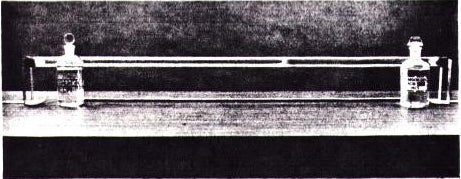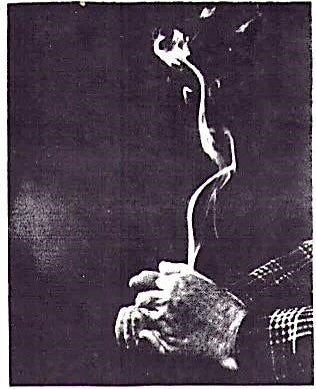Kudos to Carlos Correa for his "Chemistry in Pictures Winner: Ammonia and hydrochloric acid" on the cover of the March 2014 issue. Chem 13 News readers should be interested in my related demonstration.1 Not only does it involve active student participation, but it also provides quantitative proof of Graham's law that relates the ratio of the rates of diffusion of two gases.
High school chemistry teachers can use the familiar reaction between gaseous ammonia and hydrogen chloride in a quantitative demonstration of Graham’s law of diffusion (the rate of diffusion of a gas is inversely proportional to the square root of its molecular weight). Suspend a long, scrupulously dry tube horizontally as level as possible with a ring stand and clamp at each end. Saturate separate pieces of cotton with concentrated aqueous ammonia and hydrochloric acid and simultaneously insert them into the ends of the tube, which is then closed with rubber stoppers (Fig. 1).2

Fig. 1: Diffusion apparatus showing the deposit of ammonium chloride where the gases met.
Ask the class to predict whether the gases will meet at the center of the tube, closer to the NH3, or closer to the HCl (the correct answer). Within 10 minutes a white deposit of NH4Cl forms at the point where the gases meet:
NH3(g) + HCl(g) → NH4Cl(s)
Measure the distance of the deposit from each piece of cotton. According to Graham’s law, the ratio of the rates of diffusion is:
rNH3/rHCl = (mwHCl/mwNH3)1/2 = (36.46/17.03)1/2 = 1.463
Considering the crudity of the apparatus, the absence of a diffusion plug, the presence of convection currents, and the fact that solutions of different concentrations rather than gases are used, the results obtained are usually remarkably close to the theoretical prediction. Tubes ranging in inner diameter from 1.7 cm to 2.4 cm give good results. The larger the diameter of the tube, the faster the deposit is formed, but the more spread out it is. The longer the tube, the better the quantitative results should be, but often this doesn’t happen because convection currents arise during the longer reaction time, causing mixing of the gases. A tube 130 cm long and 1.7 cm inner diameter gives satisfactory results. The deposit forms predominantly on the bottom of the tube because of gravity and the density of the gases.
The formation of NH4Cl from NH3 and HCl can also be used in two related demonstrations.
If you take the stoppers from bottles of concentrated NH3 and concentrated HCl and hold them within 5 cm of each other, the NH4Cl smoke forms on the HCl stopper because the NH3 diffuses faster than the HCl does.3
Years ago I did a demonstration to illustrate that students needn’t panic when they spill acids or bases on themselves but have time to go calmly to the sink. I used to invert an open bottle of concentrated NH3, the mouth of which is held tightly against the palm of one hand, and then repeat the process with a bottle of concentrated HCl on the other hand. When I brought my hands together, cupped them, and compressed them, smoke rings formed. I was careful not to allow the palms of my hands to touch because the heat of neutralization would have caused burns! (Fig. 2). I imagine this demonstration can be added to the many stories from the “good old days” and would no longer be acceptable for safety reasons.
 References and notes
References and notes
- George B. Kauffman, Ronald D. Ebner, Gaseous Diffusion: A Demonstration of Graham’s Law, Journal of College Science Teaching, September/October 1985, 15(1), pages 78-79.
- Although it has long been known that “ammonium hydroxide” doesn’t exist, and although this fact was called to the attention of chemistry teachers more than six decades ago (John B. Davis, Ammonia and “Ammonium Hydroxide”, Journal of Chemical Education, October, 1953, 30(10), page 511), bottles of aqueous ammonia are still almost invariably labeled “ammonium hydroxide, NH4OH”. You can use this fact to remind students not to believe everything that they read, even if it is embossed in glass.
- Herbert Franklin Davison, A Collection of Chemical Lecture Experiments, The Chemical Catalog Co., New York NY, 1926, page 73.







